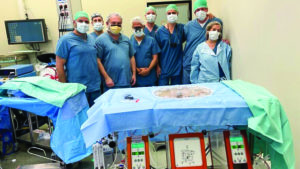By Maayan Hoffman
Technology aims to make more livers available for transplantation

For the first time in Israel, donor liver machine perfusion (MP) was performed before transplantation, and the improved liver was successfully transplanted into a patient, reported Tel Aviv Sourasky Medical Center earlier this month.
MP is a preservation method that has been developed to reduce the incidence and severity of donor liver injury and to improve outcomes after organ transplantation, said Dr. Yaacov Goykhman, head of the Organ Transplant Unit at the hospital.
“Liver transplantation is a life-saving and complicated procedure because of the patients’ medical conditions, the complexity of liver transplantation and because the organ can only survive outside the body for a short period of time,” he said. “This [liver MP] is a significant event that could revolutionize liver transplantation in Israel.”
Specifically, a patient received a liver from a donor after brain death. During the operation, the liver was prepared on the machine, and “it was a remarkable success, and the patient who received the transplant is now recovering from the operation,” said Goykhman.
A shortage of organs available for transplantation remains an issue worldwide, and for the last few decades, little progress has moved the supply. According to the organization Donate Life, some 8,000 Americans die each year waiting for a transplant.
Goykhman said Israel has also seen a shortage of organs, including livers.
At the same time, there are sometimes “marginal livers,” such as those from aged donors or individuals with significant comorbidities that are discarded for transplantation because of the high risk of the non-function. In addition, as doctors use an increasing number of marginal livers, they are concerned about their functionality post-transplantation.
He said in recent years, technology has been developed for the perfusion of the liver with a machine for the purpose of improving the organ and better evaluating its function.
There are two types of perfusions: cold perfusion with oxygen, which is used to improve the quality of marginal livers; and perfusion at body temperature, which is what allows doctors to assess the function and to decide which grafts are suitable for transplantation.
The specific machine used in Israel, which was developed by Organ Assist in Holland, combines both kinds of perfusion. For now, it is only available in Israel at Sourasky.
Discovery could help stop spread of pancreatic cancer cells in liver
A team of researchers from Tel Aviv Sourasky Medical Center has discovered how pancreatic cancer cells spread in the liver, which could be key to developing treatments to slow it down and prolong patients’ lives.
The study, led by Dr. Tami Rubinek, head of the hospital’s oncology research lab, together with Ph.D. student Shani Journo and under the auspices of professor Ido Wolf, found that a mutation that causes the disappearance of the “p15” and “p16” proteins — named for their molecular weight — appears more in liver metastasis and less in pancreatic cancer tumors in the pancreas or other areas of the body, such as the lungs or abdomen.
The liver is often the “killing organ,” Wolf said, meaning patients often die when pancreatic cancer spreads to their liver.
In general, pancreatic cancer is one of the top 10 deadliest cancers, among a list prepared by Live Science that includes such cancers as gallbladder, esophageal, liver and lung cancers. Wolf said that once pancreatic cancer starts to spread, patients generally only live between six months and a year.
Between 800 and 900 cases of pancreatic cancer are diagnosed annually in Israel, according to the Israeli Ministry of Health website. In the United States, some 60,000 new cases are diagnosed. According to Wolf, the numbers are steadily rising.
He said that the next step would be to find treatments based on the findings of the study.
Wolf cautioned that it is unlikely that the information will lead to a cure for this particular cancer. However, he said it would likely lead to treatments that could prolong patients’ lives.
Until this study — the largest of its kind, which included 17,000 pancreatic cancer patients from around the world whose information was entered into a database of FoundationOne, one of the world’s largest cancer genomics companies — it was assumed that all pancreatic cancers were similar, with no subgroups.
“The study … reveals the Achilles heel of the cancer cell,” said Wolf.
Dr. Ayelet Erez of the Weizmann Institute of Science, an expert in the dynamics of cellular metabolism, who is unconnected to the Tel Aviv research, confirmed the novelty of the study and its potential implications.
“The novelty of the paper is in promoting the concept that the metabolic landscape of the distant organ affects metastasis tropism of primary cancers,” she said. “The results of this work have translational implications as they expose metabolic vulnerabilities of the metastasizing cells that can be targeted for therapy.”






